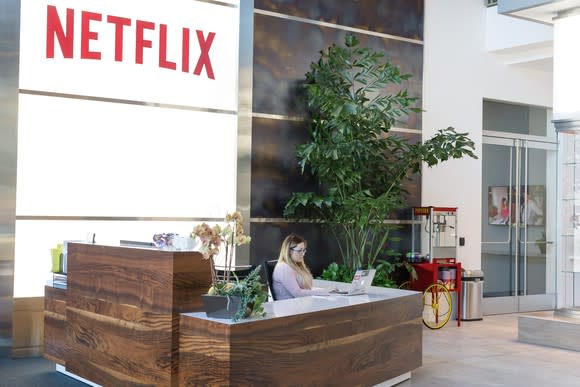If You Think Netflix Has Cash Flow Problems, Wait Until You See Hulu and Amazon
While Netflix (NASDAQ: NFLX) investors were celebrating after the company's latest earnings report, Wall Street's accounting mavens came out of the woodwork to bash the streaming video pioneer, crying foul at the company's plans to finish 2018 with $3 to $4 billion in negative free cash flow.
Netflix argued that it was growing so quickly that it made sense to fuel its growth with increased investments in content. Even so, the bears were skeptical, claiming that it was foolish to take out more debt while the company was burning billions in cash each year.
But the company's strategy is far from unique in the streaming industry. In fact, when compared to rivals like Hulu and Amazon (NASDAQ: AMZN), Netflix's approach looks downright conservative.

Image source: Netflix.
Money down the stream
Hulu, which is owned as a joint venture between Walt Disney (NYSE: DIS), 21st Century Fox (NASDAQ: FOX) (NASDAQ: FOXA), and Comcast (NASDAQ: CMCSA), each of which owns a 30% stake, and Time Warner (NYSE: TWX), which controls 10%. The service has played second fiddle to Netflix in the streaming arena for years. While Netflix has more than 52 million domestic subscribers, Hulu counts only about 17 million, and worse, the joint venture is operating at a significant loss. Hulu finished 2017 $920 million in the red as its net loss expanded from $531 million in 2016 and $318 million in 2015. The company is spending heavily to build out its subscriber base, focusing on originals and launching a live TV service.
Meanwhile, the Hulu owners invested a total of $1 billion in cash last year on the service as part of its $2.5 billion content budget. It's worth noting that while Netflix is losing cash, it's still profitable on an accounting basis. Hulu, on the other hand, is seeing its loss widen every year, and that's expected to continue next year as the company invests even more. According to analysts, the company's loss is on track to expand by 80% this year to $1.7 billion, while investments from its corporate parents will increase to $1.5 billion.
The numbers at Amazon are harder to parse, as the e-commerce giant keeps its customer data close to the vest. Amazon does not disclose the number of Prime subscribers it has, but the company brought in nearly $10 billion in subscription services, mostly from Prime, over the last year. The bulk of that spending, however, goes to free two-day shipping, which is the core perk for that membership -- the company spent more than $21 billion on shipping costs.
Amazon's content spending was estimated at $4.5 billion last year, and considering video streaming is a free add-on of Prime, it derives little direct revenue.
That investment essentially acts as a loss leader. CEO Jeff Bezos has explained the company's video strategy, saying, "When we win a Golden Globe, it helps us sell more shoes." The video content is there primarily to entice customers to join or stay on Prime, thereby prodding them to spend more on Amazon merchandise.
A booming market
Netflix, Hulu, and Amazon are throwing billions of dollars into the streaming void for one reason. This is a huge potential market, and all three of them want to make sure they have a sizable piece of it as it matures. The global entertainment and media market is estimated to be worth about $2 trillion, with the U.S. market alone worth about $700 billion. It's no wonder that streaming is attracting entrants like Apple and Facebook, even though they're unlikely to make a profit from it anytime soon.
CEO Reed Hastings predicted a few years ago that internet TV would rise every year for the next 20 years, while linear TV would decline -- and that prediction is looking increasingly accurate. Considering the size of the opportunity, it isn't surprising to see companies willing to put up with such losses. This is common in the business world in the introductory phase of an industry. Tesla, for instance, is losing billions as it tries to scale up as an electric car manufacturer, and Uber is in the same situation as it tries to dominate app-based ride-hailing.
In a fast-growing industry, losses are often a sign that competitors see huge opportunities and profits ahead. While that may not always bear out, Netflix's accounting profits show that video streaming is a sustainable industry. Compared to Hulu and Amazon, it's a mistake to discredit Netflix for its negative free cash flow. At this stage in the game, that's merely table stakes.
More From The Motley Fool
John Mackey, CEO of Whole Foods Market, an Amazon subsidiary, is a member of The Motley Fool’s board of directors. Jeremy Bowman owns shares of Apple and Netflix. The Motley Fool owns shares of and recommends Amazon, Apple, Facebook, Netflix, and Walt Disney. The Motley Fool has the following options: long January 2020 $150 calls on Apple, short January 2020 $155 calls on Apple, short March 2018 $200 calls on Facebook, and long March 2018 $170 puts on Facebook. The Motley Fool recommends Comcast and Time Warner. The Motley Fool has a disclosure policy.

 Yahoo Finance
Yahoo Finance 